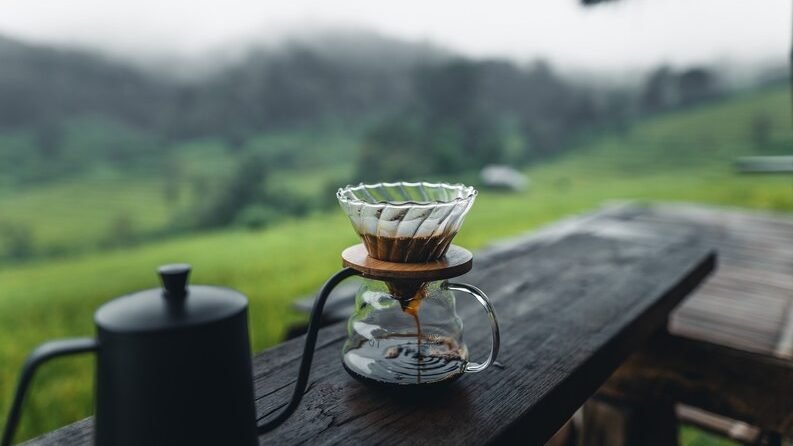Single Origin Sumatra Coffee: A Journey Through the Indonesian Highlands

Single Origin Sumatra Coffee is a distinctive and sought-after coffee variety that originates from the Indonesian Highlands. This article provides an overview of this unique coffee, highlighting its flavor profile, cultivation methods, cultural significance, and challenges for its future.
Single Origin Sumatra Coffee refers to coffee beans grown exclusively in the Indonesian Highlands, particularly in the regions of Aceh, North Sumatra, and Gayo. These beans are renowned for their rich flavors, earthy undertones, and unique processing methods.
Also Read: Why Indonesian Arabica Coffee is a Must-Try for Coffee Lovers
Geography and Climate of the Indonesian Highlands
Location and Topography
The Indonesian Highlands are located in the western half of the Indonesian island of Sumatra. Aceh, North Sumatra, and Gayo are among the provinces that make up the region. The topography is harsh and mountainous, with numerous active and dormant volcanoes dotting the area. Mount Kerinci, Indonesia’s highest volcano, is located in the Indonesian Highlands.
Climate and Environmental Factors
The tropical climate of the Indonesian Highlands is impacted by the region’s equatorial location. Throughout the year, the climate is marked by high humidity and heavy rainfall. The average annual rainfall is between 2,500 and 3,500 millimeters, with some places receiving significantly more. The rainy season lasts from October to April, and the dry season lasts from May to September.
The high elevation of the region has a significant impact on the climate. Temperatures fall as height rises, creating a cooler and more temperate atmosphere than the lowlands. Temperatures in the Indonesian Highlands range from 18 to 24 degrees Celsius on average, making it ideal for coffee growth.
Impact on Coffee Cultivation
The Indonesian Highlands’ distinctive terrain and climate contribute to optimum circumstances for cultivating high-quality coffee. The region’s volcanic soil is rich in minerals and nutrients, creating a suitable setting for coffee plants to grow. The elevation, which ranges from 1,000 to 2,500 meters above sea level, contributes to the formation of a colder microclimate, slowing the maturation of the coffee cherries and allowing for more subtle flavor development.
The high amounts of rainfall and humidity encourage the establishment of lush vegetation, which provides natural shade for coffee plants. This shadow shields the coffee trees from direct sunshine, reducing heat stress and permitting a slower ripening process. Furthermore, the regular temperatures in the Indonesian Highlands aid in the balanced development of tastes in coffee beans.
History of Coffee in Sumatra
Arrival of Coffee to Indonesia
Sumatra’s coffee history extends back to the late 17th century when the Dutch East India Company brought coffee to the archipelago. The Dutch traders introduced Yemeni coffee seedlings to their Java colony, where they developed the first coffee plantations. Because of the success of coffee planting in Java, coffee production has spread to other parts of the Indonesian archipelago, including Sumatra.
Development of Sumatra as a Coffee-Producing Region
Sumatra’s coffee production rose to prominence during the Dutch colonial era. Local farmers began growing coffee, and the region became known for its unique processing methods, which resulted in the distinct flavors found in Single Origin Sumatra Coffee.
Also Read: Indonesian Coffee Beans: Flavorful Delights with Mandheling Coffee
Characteristics of Single Origin Sumatra Coffee
Flavor Profile
Unique Origin Sumatra Coffee is well-known for having a distinct flavor character. It has a full-bodied and earthy flavor with a low acidity. Complex undertones of dark chocolate, wood, tobacco, and spices like cinnamon and cardamom may be found in the flavors. Hints of tropical fruits, such as tamarind or mango, may also be present in the coffee, lending a touch of sweetness to the entire flavor.
Processing Methods
The unique processing procedure known as “Giling Basah” or wet-hulling is one of the distinguishing features of Single Origin Sumatra Coffee. This method entails removing the outer skin and some of the pulp from coffee cherries before drying them. Wet-hulling adds to the particular flavor profile by letting the beans absorb more moisture during the drying stage, resulting in reduced acidity and a heavier body.
Unique Qualities and Attributes
Single Origin Sumatra Coffee possesses several unique qualities that set it apart from other coffee varieties:
- Heavy Body: The coffee has a thick, syrupy body that provides a rich, velvety mouthfeel. This feature gives the coffee a strong presence and improves the whole sensory experience.
- Single Origin: Low Acidity Sumatra Coffee is distinguished by its low acidity when compared to other coffee kinds. The coffee’s low acidity allows the other tastes to shine through, contributing to its smooth and balanced flavor.
- Flavor Retention: Single Origin Sumatra Coffee beans have an amazing capacity to keep their flavors over time. This makes them excellent for storage and transportation, guaranteeing that the particular flavor and scent remain intact even after long periods of time.
Single Origin Sumatra Coffee is widely sought after by coffee aficionados and connoisseurs due to its distinct flavor profile, wet-hulling processing method, and remarkable attributes. Its unusual qualities lead to its success in the specialty coffee industry, making it a popular choice for people looking for a robust and memorable coffee experience.
Processing and Production of Single Origin Sumatra Coffee

Harvesting and Sorting
The meticulous and selective selection of ripe coffee cherries begins the process of manufacturing Single Origin Sumatra Coffee. Handpicking the cherries ensures that only fully matured cherries are selected for further processing. This rigorous harvesting method is critical in preserving the coffee beans’ freshness and flavor.
Following harvest, the coffee cherries are sorted to remove any damaged or faulty cherries. This sorting procedure ensures that only the best beans are processed, which improves the overall cup quality of Single Origin Sumatra Coffee.
Traditional Wet-Hulling Method
Unique Origin Sumatra Coffee is famous for its distinct processing method known as “Giling Basah” or wet-hulling. This process is unique to the region and adds to the coffee’s distinct flavor profile.
The outer skin and portion of the pulp of the coffee cherries are removed mechanically or by hand during wet-hulling. Before the parchment coating is removed, the beans are briefly dried, typically to a moisture level of around 30-40%. This is in contrast to the more frequent dry processing approach, in which the cherries are dried completely before the parchment is removed.
The high humidity in the Indonesian Highlands aids the wet-hulling process by allowing for speedier drying. The earthy and full-bodied flavor characteristic associated with Single Origin Sumatra Coffee is enhanced by wet-hulling. It also imparts a characteristic bluish-green tint and a slightly mottled aspect to the beans.
Sun-Drying and Storage
The coffee beans are spread out on patios or raised beds to dry in the sun after being wet-hulled. Sun-drying is an important phase in the manufacturing process since it develops the taste and removes excess moisture from the beans. The drying process usually takes several days, during which the beans are turned on a regular basis to achieve even drying.
The coffee beans are carefully preserved once they have reached the desired moisture level of roughly 12%. Proper storage conditions, such as keeping the beans cool and dry, assist in preventing moisture re-absorption and preserving the coffee from external variables that can affect its flavor.
Single Origin Sumatra Coffee’s processing and production processes, such as selective harvesting, wet-hulling, and sun-drying, contribute to its distinct flavor profile and overall quality. These time-honored methods passed down through generations, are essential in the cultivation of this excellent coffee varietal.
Also Read: Wet Hulled Coffee Process: Unique Technique from Indonesia
Appreciating and Brewing Single Origin Sumatra Coffee
- Choosing and Storing Beans
When selecting Single Origin Sumatra Coffee, look for freshly roasted beans from reputable sources. Store the beans in an airtight container away from light, moisture, and strong odors to preserve their freshness. - Brewing Methods and Techniques
Single Origin Sumatra Coffee can be brewed using various methods such as pour-over, French press, espresso, or cold brew. Experiment with different techniques to find the brewing method that best enhances the coffee’s flavor profile. - Tasting and Sensory Experience
When tasting Single Origin Sumatra Coffee, pay attention to its full-bodied texture, earthy flavors, and unique notes. Observe the aromas, acidity, sweetness, and aftertaste to fully appreciate the complexity and richness of the coffee.
Conclusion
Exploring the Indonesian Highlands and the journey of Single Origin Sumatra Coffee reveals a rich and diverse coffee experience. From its unique flavor profile and traditional processing methods to its cultural significance and challenges, Single Origin Sumatra Coffee stands as a testament to the region’s rich coffee heritage. Embrace this distinctive coffee, appreciate its flavors, and contribute to its sustainable future in the world of specialty coffee.











